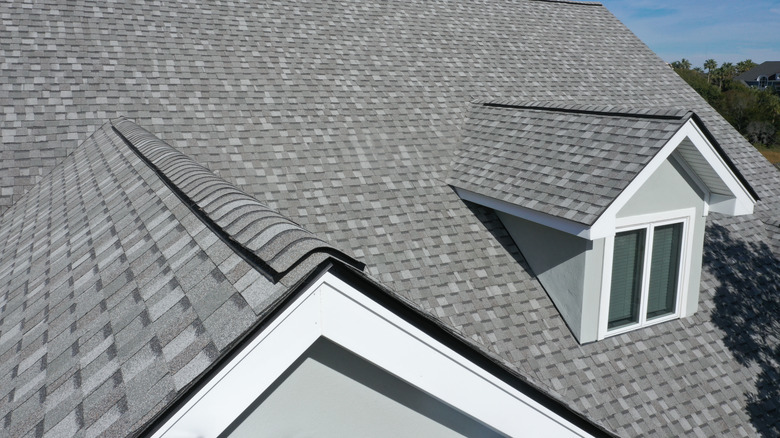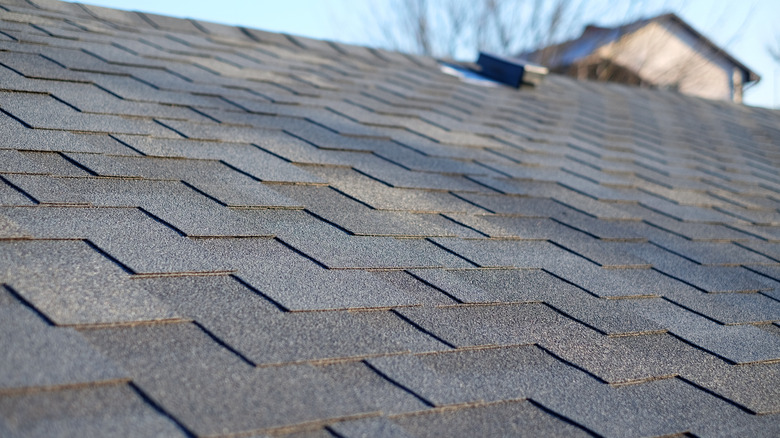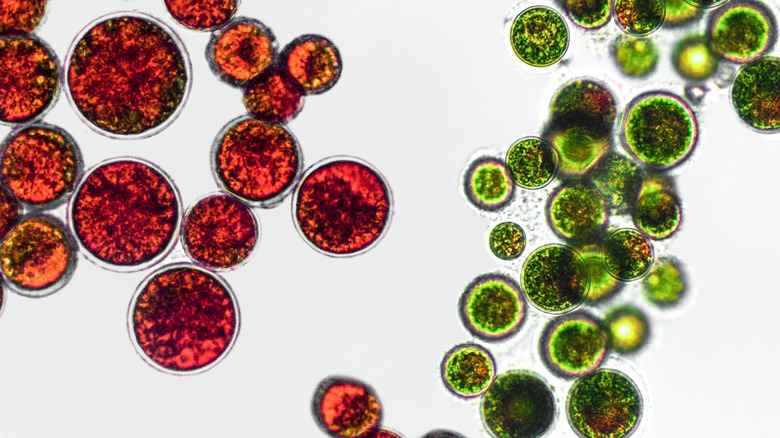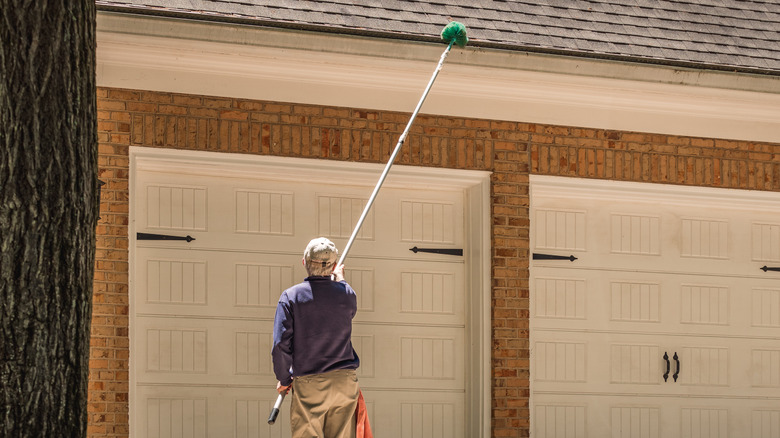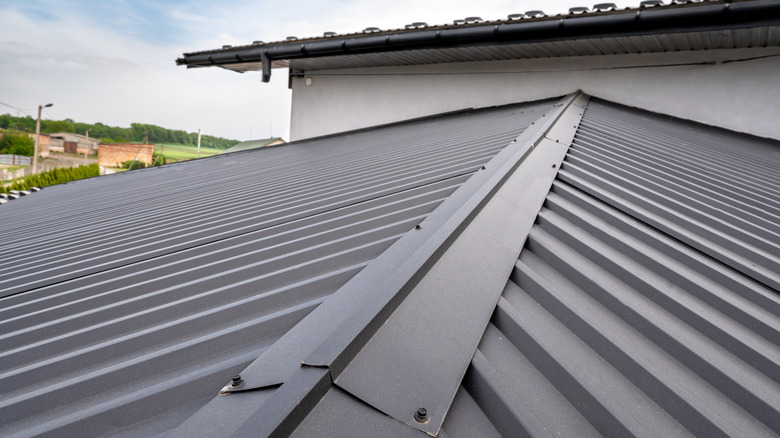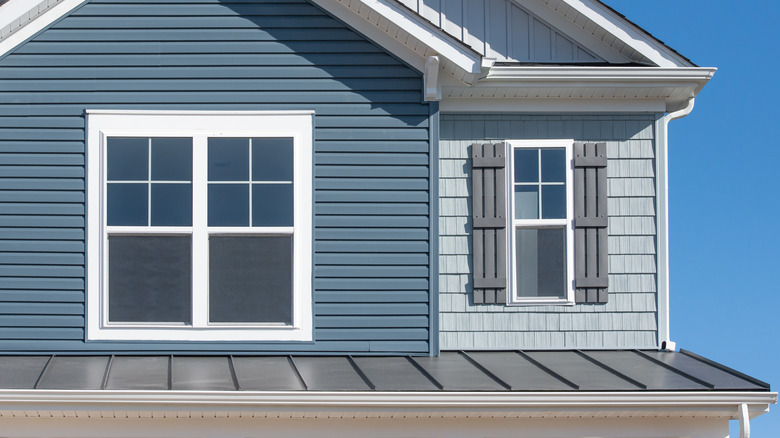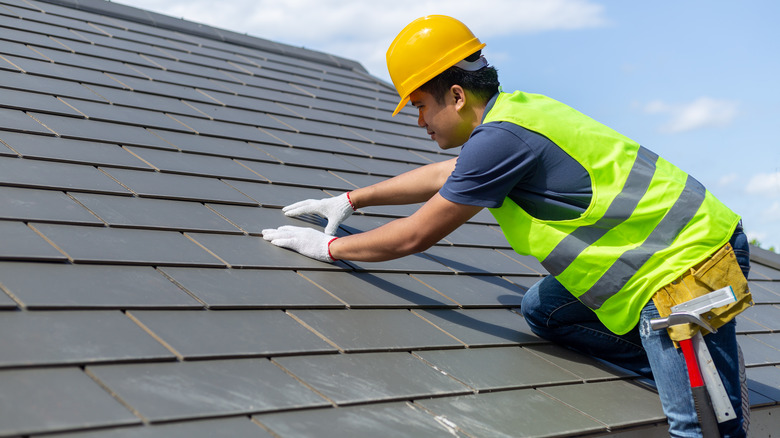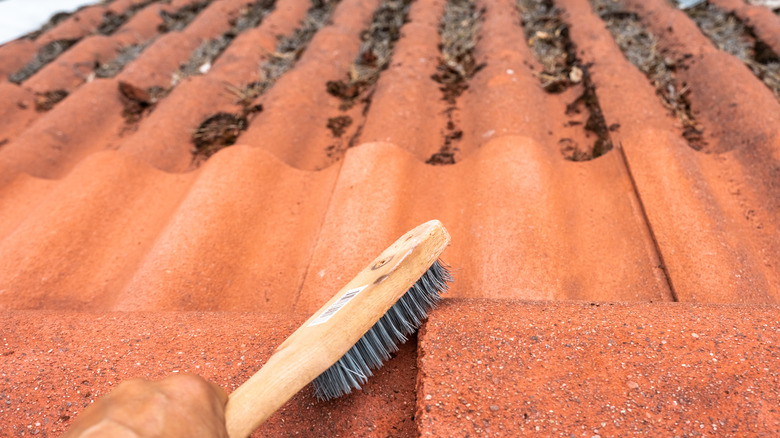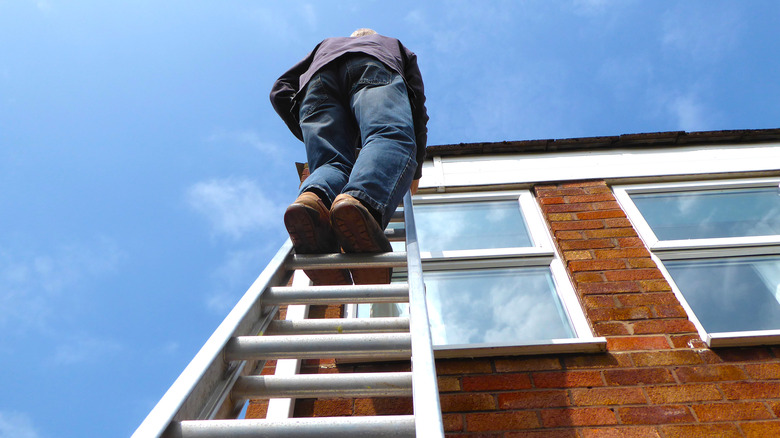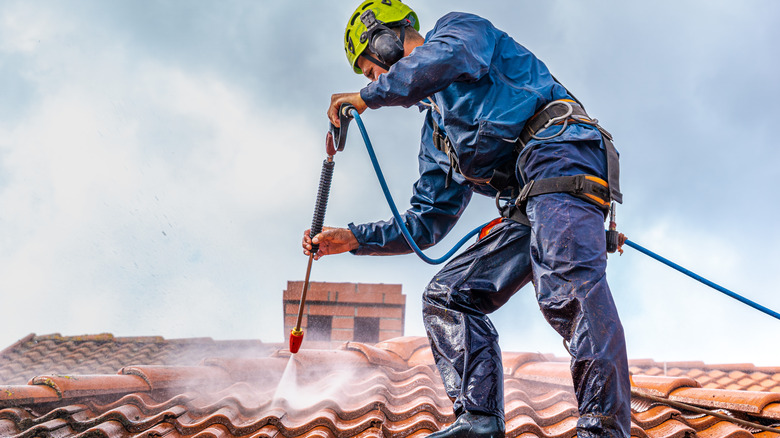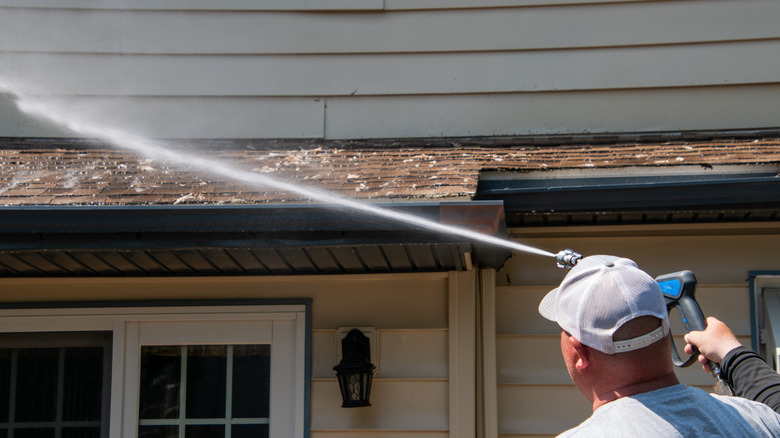How To Get Rid Of Roof Stains
We may receive a commission on purchases made from links.
According to Build Magazine, curb appeal is that little extra something about your home that makes it look appealing when you're pulling up in the driveway, to your neighbors across the way, or potential buyers if you're selling. A few things often addressed when trying to beef up your curb appeal are the front door, the planters by the mailbox, the driveway, and even the grass on the front lawn. However, have you considered the roof of your home?
Replacing or fixing a roof is a significant expense, so it's one of those factors that buyers want to know about right away. If you're trying to sell, a stained and old-looking roof isn't going to attract anyone's eye. When you pull into the driveway, if you feel the first thing you spot are the streaks and stains around your roof, then it may be time to try and spruce up the shingles or other roofing materials. Not to mention, curb appeal can boost the value of your home and the whole neighborhood's property value. Why not give your roof a little TLC? Try out some of these methods and preventative steps for cleaning and maintaining the many types of roofs out there.
Different types of roofing
There are several different roofing types to choose from. Some are recognizable, and some are rare. However, the most common type of roofing in the United States is asphalt shingles, which fare well in all weather conditions, as per Nationwide. Metal roofing is available in several styles, most of which last approximately 50 to 70 years. They are especially great for areas with heavy snowfall since snow and ice will slide off metal easier than shingles or slate. Slate tiles are beautiful on a roof, but they can be an expensive alternative. Homeowners can also choose clay or concrete tiles, which withstand high winds and harsh conditions. However, tiles such as this can break if you're walking on them, so you'll need to be careful while cleaning.
The way these materials hold up is crucial, but you'll also want to ensure they look good. Stains on your roof may not seem like a big game changer, but you're bound to appreciate the difference.
What causes stains on asphalt shingles
Before diving into what causes stains on asphalt shingles, it's important to understand what they're made of. According to Asphalt Magazine, asphalt shingles became prevalent in the early 1900s, when builders needed a cheap but efficient fire-resistant roof. These types of shingles are made up of either glass or cellulose fibers. The top layer of asphalt covers the base, and granules or small beads are added to it to give it color, make it textured, and help make it even more fire-resistant.
Asphalt shingles look pristine when they're first installed. However, over the years, you may notice some areas that are darker than others, streaks or run marks, and other types of stains that simply don't look great from the street. According to Perry Roofing, these stains and other discolorations will not ruin your roof, but you may still want to get rid of them. The most common cause of stains on asphalt shingles is Gloeocapsa Magma or blue-green algae spores that occur in areas with high humidity. These spores travel through the air and come to rest on your roof. The reason the roof appears discolored in certain spots and not others is that most roofs have small amounts of copper and zinc on them, which is toxic to algae. This creates an uneven color on your roof that can make it look stained and old.
How to clean asphalt shingles
The most important question, whether you are sprucing up your curb appeal or trying to sell your home, is how to clean these stains away and get your roof looking fresh again. There are multiple ways to clean these stains. However, some can damage the shingles' life expectancy and harm surrounding plant life, and some are more preventative than others. According to Perry Roofing, chemical cleaners are available to fight algae for a time, but they will likely need to be reapplied. If you're not careful, a chemical cleaner used repeatedly could damage the shingles and need replacing sooner. Another way to clean stains on your roof is to try power washing. This is a common solution because it avoids chemicals, some homeowners already own a washer, and it could be less expensive. However, power washing your roof can strip away the small granules on your shingles and cause damage. These methods may work for you if the problem doesn't seem persistent and if you are careful or hire a professional.
According to Asphalt Roofing, combining a mixture of 1/2 chlorine bleach and 1/2 water is the best solution for cleaning your roof. Carefully apply the mixture with a sprayer to your shingles, and after letting it sit for approximately 20 minutes, you can then gently rinse the mixture away with a hose. This method falls under the chemical cleaner option, which can cause damage after repeated uses, and the runoff will be dangerous for surrounding plants and animals. These options will likely need to be repeated depending on if the algae are prevalent in the area.
What to know about metal roofs
Metal roofs are an alternative material that is growing in popularity and can often be found in mobile homes, sheds, garages, and more. Stains on metal roofs are just as unsightly as on shingles, but can also be a sign of trouble, whereas stains on asphalt shingles aren't usually harmful.
Tin roofs may come to mind when you think of metal roofing, but according to Bridger Steel, there are five different types to choose from. Tin, copper, aluminum, zinc, and steel are the most common metals, and they each have a unique range of pros and cons that could suit your individual needs, whether it's pricing, longevity, or the climate you live in. For example, copper will last for over 200 years and is recyclable, but aluminum is a better choice if your home is exposed to a lot of salt sea air. The one thing you can be sure about with all metal roofs is that rust stains are a sign of damage, and you'll want to address those stains quickly.
How to clean metal roofs
Keep your roof gleaming and fight against wear and tear by routinely cleaning your metal roof. What is the best way to do that? There are quite a few methods and safety tips to consider. According to Bridger Steel, one of the most important safety tips to remember is that metal roofing is slippery, especially if it becomes wet with a cleaning solution. It can also get very hot, especially when compared to shingles. To begin, choose a day with no chance of rain and one that is not too sunny or hot. You'll also want a partner to assist you and shoes with excellent traction. Then you can start clearing the debris off your roof. Piles of leaves, branches, and stray pieces of plastic and paper can build up on your roof. It's important to clear these away, not only because they look bad but because they can trap water and cause rust. Start the cleaning process by brushing debris away with a broom, being careful not to damage the gutters. You can also consider using a hose or a blower to remove debris.
Once the area is clean and dry, you can use a cleaning solution with a sponge, cloth, or bristle brush. Do not use steel wool or hard bristles that will cause scratches. Consider washing your roof the same way you would your car. Bridger Steel suggests using 1/4 of a cup of light cleaning detergent in 1 gallon of water to clean away hard stains. Let the solution sit for 10 minutes, then carefully rinse with a hose. Power washing is another option, but they can be hard to handle and can dent the metal, so use them with caution.
Slate roof tiles and how to clean them
Slate roofing tiles are not for homeowners and builders with a small budget, as per Nationwide. This choice of roofing material has many pros, such as being waterproof and fire-resistant. The tiles will often last up to 100 years and look stunning; however, they are heavy, easily broken, and cost a lot compared to some other roofing options.
Slate has been used for roofing for hundreds of years and continues to be a useful material for homeowners. However, no roofing material is perfect, and stains on slate roofs can still occur. According to Pacific Exterior Advanced Cleaning and Restoration, algae and other fungi on slate roofs can cause discoloration, and oxidizing minerals can create reddish stains. Cleaning fungi and algae from slate roofs can be done with simple cleaning mixtures and a power washer or hose. However, hiring a professional to clean slate roofs is highly recommended. The tiles are fragile and can break under the pressure of power washers, and they are extremely expensive to replace. Also, delamination, when the slate begins to break down into layers, can be exacerbated by power washing and shorten the lifespan of your slate roof tiles.
What brush to use to clean your roof
If you aren't afraid to get your hands dirty, then you'll need the correct brush to clean your roof like a pro. If you choose the right brush, you can effectively clear away debris, remove moss, and scrub off stains from shingles and other metal roofs. According to Roof Scour, for a large roof, you will need a broad, soft-bristled brush so it won't damage shingles. An example is the Garelick 21-Foot-Long Leaf Roof Brush, which is easy to handle and works on most roofs, whether you are clearing away sticks and leaves or scrubbing away algae stains and moss.
For an asphalt shingle roof, you may also want to consider an angled brush, such as the Fuller Brush Angle Broom, to easily get in the grooves and corners of your roof. If your roof has stubborn stains that won't come out with a simple sweeping, you may want a smaller hand-held wire brush that can get into the smallest places and be applied with more pressure. A set similar to the Wire Brush Set for Roof Tile Moss is great if you want to get down into the nitty gritty part of scrubbing and scraping your roof. If you want more length and something to clear away dirt and dust from the corners of your roof and your gutters, try a brush like the Daisypower Angled Roof Gutter Cleaning Brush that is flexible and easy to maneuver. For a metal roof, consider a softer bristle than the ones for asphalt shingles. The paint may scrape, or the metal may scratch if your bristles are too stiff.
How to safely use your ladder and other precautions
Safety is always a priority for home improvement and DIY projects. Getting injured or damaging your house while trying to learn a new skill or saving money is the opposite of what you're striving for, which is why safety must be a priority. According to the American Ladder Institute, the most common reasons for ladder injuries are ladders in poor condition, rushing, improper footwear, and lack of focus.
If you are cleaning your roof yourself, you'll need a ladder to get onto the roof or reach certain areas. It is important to wear the proper footwear to avoid mishaps and injuries. They should be tied tightly and have lots of traction on the bottom that isn't too worn. Before climbing the ladder, be sure the ground is level, and pay attention to your surroundings. Don't forget to double-check the weight restrictions for your ladder, always face the ladder when climbing up or down, and remember the three-point-of-contact rule when climbing. This rule means that at all times while climbing, you should have either two feet and one hand or one foot and two hands securely on the ladder. Firm contact with a secure ladder greatly decreases your chance of falling. The climber should never carry items while climbing, especially bulky brooms, heavy buckets, or other items that could throw them off balance. Have someone pass items to you or use a tool belt if you need to transport items. Remember never to attempt to climb a ladder or clean your roof if it's raining or recently rained. Wet shoes, roofs, and ladders are too slippery and unsteady to be safe.
Power washing your roof
If your roof is blighted with unsightly stains and discoloration, it may be your first instinct to reach for the power washer. Here is everything you need to know about power washing your roof the right way. According to Pressure Washer Direct, there are a few things to avoid that are important for your safety and the condition of your roof. Do not ever aim the power washer up the roof, as this can pry up the shingles. Do not step directly on wet algae because it's very slippery. Do not use extremely high pressure on your shingles, as this can strip away granules. One way to avoid damaging your roof is to invest in a lower-pressure tip for your power washer.
Applying some cleaning solution or detergent may seem unnecessary, but it can help break down the algae and reduce the scrubbing and pressure to preserve your roofing. When choosing a detergent, choose one that is safe for pressure washers and biodegradable. There will be a lot of overspray, and your surrounding vegetation could be affected if you choose a harmful detergent. Allow the detergent to sit, scrub areas where the stains are extra tough, and then rinse the solution away, leaving your roof sparkling clean. Remember to work in sections and know where you'll need to stand to avoid slippery areas.
Prevent stains on your roof
Cleaning your roof can feel like an exhausting project and one that you do not wish to take on every two to three years. Here are a few tricks and hacks to prevent stains on your roof from developing. According to Perry Roofing, certain metals, such as zinc and copper, are so toxic to algae cells that they will not grow or accumulate where the metal is. This is why stains often look like streaks. That is actually the contrast between the stained shingles and where remnants of the metal have dripped down and scared the algae cells away. One way to prevent stains is to have a strip of metal, usually zinc or copper, on the ridge of your roof. This way, the water will hit the ridge, run down the surface of your roof, and deter algae. However, it's important to install this strip accurately, or you could cause unwanted leaks or allow water under your shingles.
You can also install algae-resistant shingles, which are specifically designed to keep algae blooms, lichen, moss, and other fungi away from the start. You can also add Roof Armor Mold Prevention and other solutions like it to a hose sprayer, which you can then apply from the yard to your roof (via CleanerToday). You simply have to spray a layer onto your roof, and you're done. There is no need to rinse the solution; you only have to apply it once a year. Who doesn't love a simple solution that will upgrade your curb appeal like a pro?
